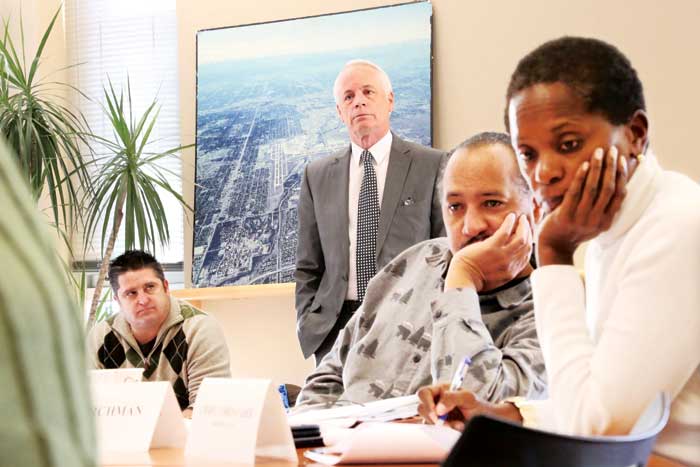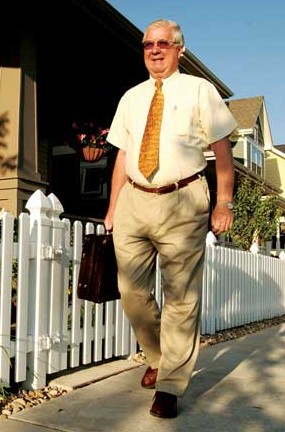How did it happen that Forest City’s contract to redevelop 4,700 acres (at a projected of cost $3.4 billion* by full buildout) was made with a volunteer board of private citizens, the Stapleton Development Corporation (SDC)?
And what happens now—when the paid staff that supports SDC has run out of funding—but they need to continue selling land to Forest City?

Cheryl Cohen-Vader, president of the Stapleton Development Corporation (right) and Kevin Marchman, SDC chairman, ponder the future of the organization. Back left, Damon Knop and Jim Wagenlander, who attended the December SDC meeting.
The story started in 1989 when Denver voters approved building DIA, and the city of Denver took on the enormous task of planning for and building a new airport. The city did not have the financial or planning resources to take on a second, almost-as-enormous, project—to remediate and redevelop 4,700 acres of blighted land left behind when the airport moved. The airport had to get the highest dollar to pay off airport debt with the sale of the land and the city had no money to put into the redevelopment. Consultants were engaged and the recommendation came back—make it an industrial area.
But even before the vote to annex the new airport land, Mayor Peña started a group called Stapleton Tomorrow. This group included business leaders, civic leaders, neighborhood activists and citizens who created a list of desires for the redevelopment of Stapleton. Stapleton Tomorrow morphed into a very active and committed Citizens Advisory Board that has continued to this day, with a number of the original people (including Happy Haynes, Jim Wagenlander, Alice Kelly and Nadine Caldwell) still actively working, 20+ years later, to ensure that the vision is achieved.
The continuing and relentless community efforts were then, and continue to be, critical to the success of the project, but they needed major financial backing to turn their ideas into a professional plan that the City of Denver would endorse. That support came in the form of a wealthy Denver oilman who shared their passion for redeveloping Stapleton into a “new urbanism” community.
Current citizens advisory board co-chair David Netz calls the Stapleton Development Plan (the Green Book), “a well-done, well thought out plan with lots of stakeholders.” City Council agreed when it was brought to them in 1995, and they unanimously voted to make it a part of Denver’s comprehensive plan.

SDC board member Happy Haynes has had numerous roles in Stapleton planning and development for over 20 years.
The Green Book recommendation for implementing the plan was for the City and County of Denver and the Denver Urban Renewal Authority (DURA) to create a third entity, a non-profit corporation governed by a board of directors, appointed by the mayor, and confirmed by Denver City Council. One of the advantages of a private non-profit entity was that it opens more financing options—in this case, private financing with the developer.
An ordinance was passed in 1995 creating the Stapleton Development Corporation. Happy Haynes, who served on city council from 1990 to 2003, recalls, “When it came for a vote it was a pretty big deal. The Green Book and the planning and how it was going to move forward were new. It was innovation. It wasn’t a developer coming into town and dealing with zoning. The fact that this started out as a community planning process and that driving what was going to happen was very unique.
“This was public land. Should some entity other than the City have this kind of control and responsibility? Some people thought a citizens group was too pie-in-the-sky and wouldn’t take the city’s financial interests into account.”
Originally the SDC board began creating a staff to redevelop the site. “Pieces were sold, things didn’t go as planned. It was complicated. No one wanted to pay for their infrastructure, so they would only buy chunks on the edges because roads and sewers were in place there. But no one wanted land in the middle. Development would have been on the edges, random rather than a quality systematic plan,” says David Netz.
Dick Anderson, who became president and CEO of SDC in 1997, believed they needed to hire an experienced developer. The board members, who had had differences of opinion on how to proceed, came to agreement on hiring a developer, got a sign-off from Mayor Webb, and started developing a request for bids. SDC would “take down” the land from DIA over time, sell it to the developer, and turn over the proceeds to DIA—giving SDC the ability to withhold land sales if they believed the terms of the contract weren’t being met.
Tammi Holloway, the attorney at SDC who handles the legal transactions, says when they get the land from DIA they “record the architectural and design declaration against the property that spells out what can be done on the land in terms of vertical development.” Bar Chadwick, from the City, says, “The Green Book is part of the City’s Comprehensive Plan and therefore is an enforceable document under the City’s regulatory powers.”

The Executive Committee of the Citizens Advisory Board (CAB) in 2000: (top) Jim Wagenlander, (2nd row) Phil Dietrich, Pat McClearn, Terry Whitney, Alice Kelly, (seated) Joyce Gibson and Geoff Peterson. Terry Whitney is currently an SDC board member and Alice Kelly and Jim Wagenlander are still members of CAB.
Dick Anderson points out that they solicited the bids to find developers who bought in to their vision. “One of the developers said, ‘It’s a pretty good plan but we have our own ideas. We’ll work with people but we’re going to tell you how to improve this plan.’ They were out the door immediately.”
In addition to Forest City’s commitment to the Green Book, Anderson points out they had the necessary marketing capability and they had deep pockets, an essential component since the city was not willing to commit any money from the general fund. Forest City demonstrated their track record and staying power. (Anderson thinks Forest City is the only one of the finalists they considered who survived the recession.)
“We were careful to be sure they don’t have total control,” says Anderson. “They don’t control the design process, they don’t control affordable housing, they don’t control the open space and therefore SDC retains some of the control.
“The great visionary at Forest City, Albert Ratner, saw this would really be something special to take this old airport and make it into something Denver would be proud of. And Forest City would get the credit. And that’s fine. They deserve a lot of credit. The neighbors and the writers of the Green Book deserve a lot of credit also. The other developers were not nearly as committed.”
Forest City president John Lehigh says, “When we started here you couldn’t go to the public bond market and issue bonds because there was no history here of a tax base to base the investment on. One mechanism of funding was for Forest City to make an advance.”
How risky was it? “It’s a risk to take on any real estate development—risk beyond what anybody would understand. It was an assessment of the risk and the opportunity and we felt really good about what the opportunity was,” says Lehigh.
Lehigh says the contractual arrangement with SDC actually does not seem unusual to Forest City. “There’s always a public dialogue with your partners, neighbors, whoever the constituencies are.”
Though it’s been primarily a collaborative relationship, there have been difficult times. The Community Advisory Board (CAB) submits an annual report to the SDC board on Forest City’s performance in certain areas. In January 2012, the CAB asked SDC to withhold land sales because the sale of homes in the affordable program was well below the level set in the contract. SDC voted to meet with the City to address the issue.
“In any process you have a lot of different views and you don’t always get what you want,” says Haynes. “But the question is do you exercise the enforcement of not selling land based on one or two breeches or do you try to continue to push forward and make the changes as we go? I think the SDC board has used more the negotiation strategy…The SDC believes this has been a collaborative relationship and that’s how we should proceed.”
CAB members who’ve been committed to monitoring compliance with Green Book principles agree the Stapleton development has been a success.“I’m a critic of some aspects, but it’s an extraordinary project and it’s been a spectacular success,” says Jim Wagenlander. “This project has had such incredible community involvement, I believe, and many believe, that has been one of the major reasons for the success of Stapleton.” CAB co-chair David Netz says he believes what has been built is actually better than the original concept.

Dick Anderson, shown walking to work in 2004 when he was president of the Stapleton Development Corporation.
But now, 13 years into a successful project, the paid staff at SDC who do the legal land transfers and support the volunteer board are facing uncertainty about their future. A flat amount was allocated to fund SDC and that money is just about gone. DIA says no more proceeds from land sales can be used for that purpose and the city, so far, says they do not have money for that purpose.
At the December SDC meeting, the volunteer board members voted to continue meeting, and under the terms of the contract they will retain their authority, but they spoke of their anger and frustration over the lack of funding for SDC staff. “The City and County of Denver has received huge benefits from the development of Stapleton, and to find ourselves in this corner is unfathomable,” said Michael Kearns. Steven Miller added, “I think the circumstances we’re facing now indicate the city is fully prepared for either the dissolution of SDC and/or the implications of the cease of operations of SDC.”
Some SDC board members then met with the mayor and requested funding so SDC staff can continue in their role as the legal entity that transfers land to Forest City. The Front Porch will follow the story and keep readers informed.
The redevelopment of Stapleton is such a complicated process that most people don’t know about or understand all the entities involved. Next month the Front Porch will continue to write about these entities and explain their roles in the redevelopment of Stapleton.
[*The DURA website shows $3.4 billion as projected cost at buildout.]




0 Comments